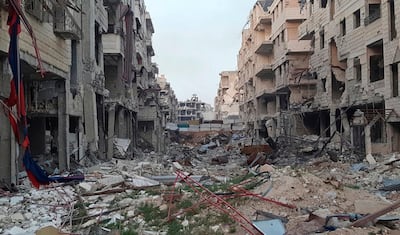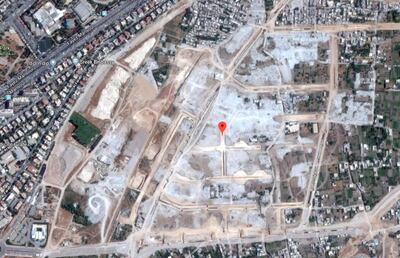Foundations are being laid for a shining new suburb in south-west Damascus. Enabled by the forerunner of a 2018 law meant to bring about the reconstruction of Syria, dump-trucks and diggers are razing and redeveloping Basateen Al Razi – the kind of suburb where anti-government demonstrations in 2011 later gave way to fighting, destructive sieges and finally, mass displacement.
Investors and government supporters hope that Syria’s Law 10 will streamline reconstruction of these areas: modern apartment blocks rapidly replacing rubble. Law 10 establishes a blueprint by dividing up areas into administrative zones with private sector backing. Current – and currently displaced – residents will be given a deadline to prove ownership of their homes, before being forced to vacate their administrative zone in return for compensation and shares in the redevelopment. Analysts and human rights groups however warn that millions of refugees and displaced Syrians could be dispossessed in the process because of difficulties with proving ownership.
__________
Read more:
With ISIS gone, Yarmouk civilians scour the rubble for homes, memories
Decree 10: yet another obstacle to Syrians dreaming of a return to their homeland
New Syrian law could prevent refugee return, Lebanese officials fear
__________
Law 10 is Syria’s latest masterplan for reconfiguring cities after seven years of war. But it is by no means the first. Successive governments in Damascus have used urban planning to control populations; recent history may indicate how the current government intends to protect itself from future unrest as well as potentially dispossessing millions of civilians deemed disloyal during the war years.
‘Re-making space’
Rebels threatened Damascus before. In 1925, the Great Syrian Revolt looked like it might succeed in overthrowing the country’s French occupiers. The autonomous Druze region broke out in revolt, followed by Hama, Damascus and other parts of Syria. But then the French crushed the local rebel bands with aerial bombings, atrocities and sieges.
If that sounds familiar, it's because the French Mandate and Syria today share a "common logic" concerned with "re-making space [and] making that space unavailable to insurgents," says Daniel Neep, author of Occupying Syria under the French Mandate: Insurgency, Space and State Formation.
"The French realised that they were incapable of winning this insurgency in traditional [or] conventional terms," Dr Neep said. "So what they had to do was change the rules of the game by putting spaces out of the reach of the rebels, creating new spaces and using urban planning to create new settlements in a way that – they thought – would reshape the Syrian people to be more docile, more easily governed."
Barricades locked the rebels out of Damascus, cutting through centres of rebellion in Al Maidan and the villages of Eastern Ghouta. Modern roads were built to facilitate the movement of military convoys. And, like today, French masterplans began with bombing sorties before the urban planners moved in. After rebels tried to infiltrate the ‘Azm Palace in the Old City, one neighbourhood was so badly bombarded that it was dubbed Hariqah, meaning "fire", and completely rebuilt with a French-designed gridiron street plan.

Like Basateen Al Razi today, Hariqah was an experiment to be applied elsewhere. Qamishli and a new town in Palmyra would be developed by French military planners, and in the 1930s Parisian planner Rene Danger was commissioned to conduct a masterplan for Damascus meant to replace what he called "indulgent, seductive, mystical and violent" Levantine urban architecture.
The French had earlier perfected "cleansing" cities when Georges-Eugène Haussmann redesigned 19th-century Paris with wide boulevards and public works meant to better protect urban space from revolt as well as improve sanitation and transport.
Gates and gardens are absorbed into the cities
By the 1960s, Syrian cities were changing again. Rural migrants were moving to the cities, often settling in informal settlements on the city limits. Place names that once demarcated the entrance of a city, or its orchards and gardens, were absorbed into suburbs. "You can almost trace some of these rough neighbourhoods by their old names," said Oxford University researcher Nate Rosenblatt, who has studied Syria’s urban-rural dynamics. Baba Amr in Homs or Bustan Al Basha in Aleppo; half a century ago these were the gates and gardens at the city outskirts.
By the mid-2000s, about 40 per cent of Syria’s population lived in informal settlements. Assad’s government never fully committed to a plan on the "slums", oscillating between legalising and upgrading them and outlawing and demolishing unregulated construction.
In 2007, a new masterplan for Damascus was underway. But by 2011, it was already too late. Simmering with local socio-economic and political grievances following several years of accelerating rural-urban migration and economic liberalisation, neighbourhoods like Baba Amr in Homs, the south Damascus suburbs and Basateen Al Razi – now site of the first reconstruction project – would quickly become epicentres of anti-government protests, then armed rebellion.
‘The uprising came from the suburbs’
"The Syrian regime did not take care of this issue of informal settlements," said Fabrice Balanche, Syria analyst at the Washington Institute for Near East Policy. "It tried to secure the Old Cities [in Aleppo and Damascus]. But the uprising didn’t come from the Old City. It came from the suburbs."
Through the conflict, urban planning has been weaponised. Human Rights Watch and the UN International Commission of Inquiry documented deliberate demolitions in neighbourhoods of Damascus and Hama between 2012 and 2013. Some reports allege that land registry offices have been used to guide demolitions campaigns, or have been destroyed altogether to erase former residents’ proof of ownership.
In Decree 66 and Law 10, the Syrian government is redressing history and rebuilding the future. The Assad government isn't turning to French Mandate plans to guide its future steps, but has demonstrated a similar interest in counter-insurgency by punishing, dispossessing and reconfiguring neighbourhoods.

Human Rights Watch recently warned that Law 10 is "poised to confiscate and redevelop residents’ property without due process or compensation," because "procedural requirements in the law coupled with the political context in which it operates create significant potential for abuse and discriminatory treatment of displaced residents and residents from areas previously held by anti-government groups." Millions have already been displaced and some 70 per cent of refugees lack basic ID documents, according to the Norwegian Refugee Council, making it hard to prove ownership.
Neighbourhoods that turned out overwhelmingly for the uprising could be razed and redeveloped, their original populations displaced and replaced by ones already part of economic, social and sectarian patronage networks. New roads will be built, cities reconfigured. Space re-made.
“It’s the same methodology of counter-insurgency" used under the French Mandate, Mr Balanche said, "applied to urban planning". The rationale being to “break the uprising and to prevent any uprisings in the future as well.”

